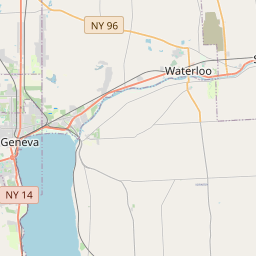Inscription
The Seneca River—the Cayuga Indians called it "Sha-Se-On-Se" or "Swift Waters". In Seneca Falls the Seneca River was a winding, rapid-filled waterway that became an important carrying place on the route from Albany to Geneva and on to the western territories. Early white settlers first built crude shelters in the area known as the "Flats", a low-lying spot now submerged beneath the waters of Van Cleef Lake.
Soon, as entrepreneurs recognized the waterpower potential of the falls of the Seneca River, thriving milling industries began. In the early 1800's a small canal was built next to the river, bypassing the falls. Beginning in 1825 this channel, known as the Cayuga-Seneca Canal, was expanded and connected to the much larger Erie Canal. This link opened national markets to products made in Seneca Falls.
In 1915, much of Seneca Falls' industrial landscape was altered forever by the merging of the canal and the river as part of a project to rebuild the Erie and Barge canal system. The original falls were submerged beneath the new waterway, leaving only the name, Seneca Falls, as a reminder of the power of the Seneca River.
Today, the Cayuga-Seneca Canal is an important recreational resource, linking Cayuga Lake, Seneca Lake, and the Erie Canal as part of the New York State Canal System. Locks 2 & 3 have a combined
lift of 49 feet, and are one of just two combination locks within the entire system.
Soon, as entrepreneurs recognized the waterpower potential of the falls of the Seneca River, thriving milling industries began. In the early 1800's a small canal was built next to the river, bypassing the falls. Beginning in 1825 this channel, known as the Cayuga-Seneca Canal, was expanded and connected to the much larger Erie Canal. This link opened national markets to products made in Seneca Falls.
In 1915, much of Seneca Falls' industrial landscape was altered forever by the merging of the canal and the river as part of a project to rebuild the Erie and Barge canal system. The original falls were submerged beneath the new waterway, leaving only the name, Seneca Falls, as a reminder of the power of the Seneca River.
Today, the Cayuga-Seneca Canal is an important recreational resource, linking Cayuga Lake, Seneca Lake, and the Erie Canal as part of the New York State Canal System. Locks 2 & 3 have a combined
lift of 49 feet, and are one of just two combination locks within the entire system.
Details
| HM Number | HM1Z95 |
|---|---|
| Tags | |
| Placed By | The New York State Canal Corporation and Others |
| Marker Condition | No reports yet |
| Date Added | Thursday, June 29th, 2017 at 6:01pm PDT -07:00 |
Pictures
Locationbig map












| UTM (WGS84 Datum) | 18T E 354093 N 4752814 |
|---|---|
| Decimal Degrees | 42.91400000, -76.78756667 |
| Degrees and Decimal Minutes | N 42° 54.84', W 76° 47.254' |
| Degrees, Minutes and Seconds | 42° 54' 50.4" N, 76° 47' 15.24" W |
| Driving Directions | Google Maps |
| Area Code(s) | 315 |
| Closest Postal Address | At or near , Seneca Falls NY 13148, US |
| Alternative Maps | Google Maps, MapQuest, Bing Maps, Yahoo Maps, MSR Maps, OpenCycleMap, MyTopo Maps, OpenStreetMap |
Is this marker missing? Are the coordinates wrong? Do you have additional information that you would like to share with us? If so, check in.
Nearby Markersshow on map
Show me all markers in: Seneca Falls, NY | Seneca County | 13148 | New York | United States of America
Maintenance Issues
- Is this marker part of a series?
- What historical period does the marker represent?
- What historical place does the marker represent?
- What type of marker is it?
- What class is the marker?
- What style is the marker?
- Does the marker have a number?
- What year was the marker erected?
- This marker needs at least one picture.
- Can this marker be seen from the road?
- Is the marker in the median?

Comments 0 comments